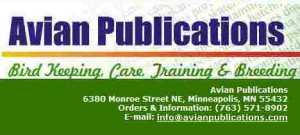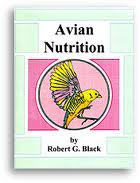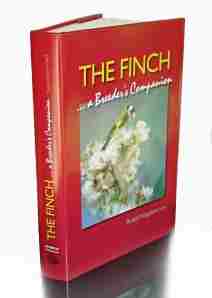Suggested Reading
TOP TEN BOOKS
FOR BEGINNERS TO FINCH KEEPING
When we first become interested in birdkeeping it is natural to want to learn all we can about the various birds kept in aviculture and particularly on the species we intend to keep. Normally, just reading bird journals and club magazines, good that many are, is never enough and it isn’t long before our thirst for knowledge drives us to shop around for some books on the subject. Unfortunately, the aspiring birdkeeper soon learns that there is an abundance to choose from and selecting those that serve his or her needs best can be a daunting task. A number of books may have striking cover photographs and be lavishly illustrated inside – but with relatively little useful information. Conversely, other books may appear positively bland and immediately ignored, whereas a more thorough inspection might reveal the pages are replete with just the information we are searching for. The old adage ‘never judge a book by its cover’ certainly applies to the avicultural literature!
Really good new books on aviculture are, sadly, seldom published today, but there are a number of excellent older ones available from specialist dealers that still contain abundant relative information. The following is my recommended list of the top ten titles that will enable anyone starting out with finches to progress from absolute beginner to potential expert.
The New Finch Handbook, by Christa Koepff, a German ornithologist, is top of my list because it contains virtually everything the newcomer to birdkeeping needs to know about exotic finches – even if the title is a little misleading (the book is concerned only with estrildid finches and not any of the true finches). The book is full of practical information, such as what to look for when purchasing a finch and the best species to start with. It is extremely well illustrated with color photographs and black and white line drawings. It is also incredible value for money, costing around £7.50.
Another very practical book dealing with mainly exotic finches but which also includes information on some of the true finches as well as cardinals is A Complete Manual for the Keeping and Breeding of Finches, by Russell Kingston. The author is an Australian and his book covers most of the species found in Australian aviculture. However, the information contained therein is applicable to British aviculture and the chapters on livefood and health are especially worthwhile as they provide beginners with an extremely useful introduction to the insect needs of particular finches and some of the more common health hazards. It is lavishly illustrated with color photographs of the species covered and is a thoroughly good read. This is a best seller in spite of the overly-inflated price for a soft-back, which is around £35.00.
The Care and Breeding of Seed-eating Birds, by Jeffrey Trollope, was first published in 1983 and has since been re-published, in 1992. It is currently available at £13.99 but can also be found for at least £2.00 cheaper on special offer. Better still, some second-hand dealers have the original edition available for less cost than the second edition. I have the first edition and am very pleased with it. The author is an English birdkeeper of long standing who writes from first-hand experience. The likes of quail and pigeons are also covered besides all four families of finches, i.e. the buntings and their allies, the true finches, estrildid finches and the whydahs, weavers and sparrows. This is another practical book, easy to read and with some good color photographs of various species.
A Manual of European Bird Keeping, by Frank Meaden, is precisely that and contains all the information you are ever likely to need to successfully keep and breed our native finches, as well as softbills. Nevertheless, the wonderfully informative information the book is renowned for is equally applicable to many foreign species and every bookshelf should contain a copy. There isn’t a color or black and white photograph to be seen, nor even an illustration of a bird, save that of a pair of blue tits adorning the front cover, but this book is an absolute goldmine of vital information. The more advanced beginner, right up to expert, will find the chapters on home-made diets and livefood culturing extremely beneficial. My hard-back edition is more than twenty years old and is now out of print (as is the later soft-back edition) but a good bookseller will find you a copy for around £15.00.
Estrildid Finches of the World, by Derek Goodwin, is acknowledged as being the finest work ever published on this family of birds. At the time of its publication, in 1982, every known species of waxbill, grassfinch, mannikin and parrot-finch was covered and very few new species have been discovered since. It is a magnificent tome written by an outstanding ornithologist who possessed incredible observation skills. Beginners might, at first, find this book somewhat daunting as it contains in-depth information of a more ornithological nature. That said, Derek Goodwin, now retired, was also a most accomplished breeder of waxbills and he includes a most enlightening chapter on keeping estrildid finches in captivity. The species chapters are essential for anyone wishing to understand the wild estrildid, which is fundamental to understanding their captive requirements. Incredibly, this book is long out of print and was never republished. It is now extremely scarce but occasionally a copy makes an appearance in the odd dealer’s establishment. Be prepared to pay around £50.00, but consider it money well spent.
Australian Finches, by Klaus Immelmann, is considered the bible for all Australian finch enthusiasts. While Goodwin’s book covered the entire family of estrildid finches, this book is concerned only with those estrildids found in Australia. The late Dr. Immelmann was a brilliant German ornithologist who was able to convey his findings in a very simple but illuminating manner. This is a marvelously written book that covers both wild and captive behavior. First published in 1965, my copy is a revised edition published in 1985. To my knowledge this was the last time the book was published, which is a great shame as it is a work of quality. Second-hand booksellers may be able to track a copy down, but considering mine cost £15.00 a number of years ago it is likely that one in good condition will sell for twice that amount. Even so, it would be worth it.
Finches and Sparrows, by Peter Clement, Alan Harris and John Davis, is an out and out identification guide to all the finches of the world (excluding buntings and their allies) and contains absolutely nothing on birdkeeping. Nevertheless, it contains some stunning color illustrations that do more justice to a species than many photographs do. For example, I have yet to see a really good photograph of a Dybowski’s Twinspot (Euschistospiza dybowskii) but the illustration in this book captures more of the true essence of the species. Then again, no birdkeeping book, no matter how good it is, ever contains pictures of every known species. This is where identification guides such as this come into their own. The species chapters also contain valuable information on the wild bird. It is believed a new edition is imminent, but the 1993 first edition is still obtainable at £29.99.
Munias and Mannikins, by Robin Restall, is to mannikin and munia enthusiasts what Immelmann’s book is to Australian finch keepers. The author, an ornithologist and aviculturist, is also one of the world’s foremost bird illustrators and as such was able to both write and illustrate this quite stupendous work. Every known species and subspecies is both described and illustrated – in full color! Whilst this work is primarily one of an ornithological nature, there are numerous references to the captive bird. If your interest is in munias and mannikins (the names are interchangeable) but you are just starting out, purchase Christa Koepff’s book and this one together and you will be set up for life. On its own, Restall’s book, which was only published in 1996, retails at £28.00.
Softbills – care, breeding and conservation, by Martin Vince, might seem a strange choice for a finch keeper but it must be realized that most finches eat livefood as well as seed, particularly at breeding time, and, therefore, an insight into keeping insectivorous birds will definitely not go amiss. This book is excellent in that much of what is written can be very much applied to seed-eaters. For example, the chapters on acclimatizing and establishing, plants, nutrition and diets and feeding are all pertinent and can be adapted to suit a particular finch species. There is a lot of sound information contained in this book’s pages and the writing is down to earth. Still in print at £18.95.
A complete checklist of the birds of the world, by Richard Howard and Alick Moore, is my final choice and may or may not be considered necessary depending on how your interest in birds takes you. This book contains nothing more than the thousands of names of every species and subspecies of bird around the world. There are no illustrations and no references to birdkeeping. Where it becomes extremely useful is when you need to know exactly which species of bird is being sold or is under discussion, be it in a book, magazine or lecture. It can be quite infuriating to see common waxbills being advertised by dealers only to find that the birds are, in fact, black-rumped or red-eared waxbills. The latter may be commonly imported but there is a bird actually called the common waxbill (Estrilda astrild), as opposed to the black-rump’s scientific name of Estrilda troglodytes. While the local names for birds can vary from country to country the scientific name never does, so you can be absolutely sure which species is being referred to once the scientific name is given. This book is usually acquired by the more experienced keeper, but as that could well be you one day it is well worth considering. The latest, 2nd edition, retails for £27.00.
(All Rights Reserved)
by: Ian Hinze
This site uses Akismet to reduce spam. Learn how your comment data is processed.




Leave a Reply
You must be logged in to post a comment.